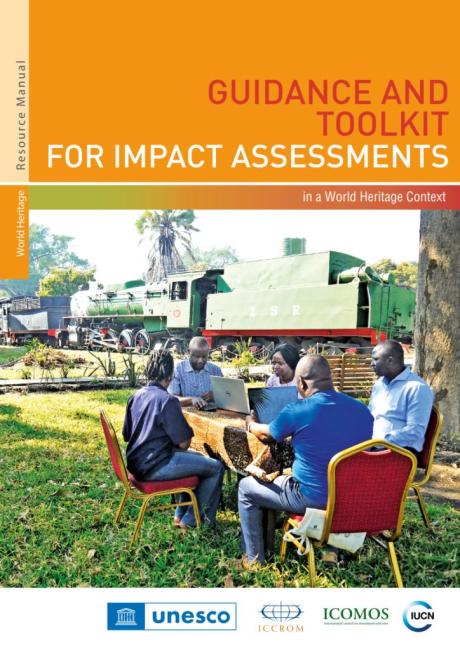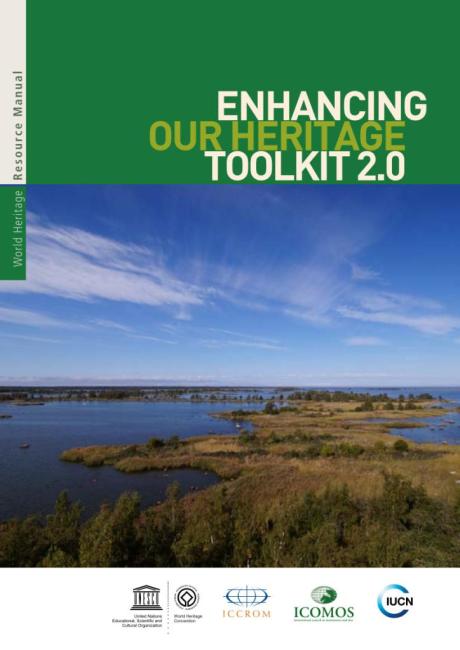Taking a place-based approach to heritage management
- A
World Heritage property
A cultural, natural or mixed heritage place inscribed on the World Heritage List and therefore considered to be of OUV for humanity. The responsibility for nominating a property to the World Heritage List falls upon the State(s) Party(ies) where it is located. The World Heritage Committee decides whether a property should be inscribed on the World Heritage List, taking into account the technical recommendations of the Advisory Bodies following rigorous evaluation processes.
When used as a general term, World Heritage refers to all the natural, cultural and mixed properties inscribed on the World Heritage List. is a defined geographical area which is valued by people for its OUV and that is located in a wider setting and place. - This place may have natural and/or cultural significance and importance for different people and at different levels that are not necessarily included in the OUV but are important enough to form part of its overall significance.
- A heritage place approach to management recognizes this interconnection between the
World Heritage property
A cultural, natural or mixed heritage place inscribed on the World Heritage List and therefore considered to be of OUV for humanity. The responsibility for nominating a property to the World Heritage List falls upon the State(s) Party(ies) where it is located. The World Heritage Committee decides whether a property should be inscribed on the World Heritage List, taking into account the technical recommendations of the Advisory Bodies following rigorous evaluation processes.
When used as a general term, World Heritage refers to all the natural, cultural and mixed properties inscribed on the World Heritage List. and the wider setting and place. - World Heritage properties need integrated management approaches which recognize their overall significance (both OUV and other heritage values), as well as their interconnections and dynamics with any buffer zone(s) and the wider setting.
- Building partnerships with the many actors associated with the heritage place and its context can help ensure a
World Heritage property
A cultural, natural or mixed heritage place inscribed on the World Heritage List and therefore considered to be of OUV for humanity. The responsibility for nominating a property to the World Heritage List falls upon the State(s) Party(ies) where it is located. The World Heritage Committee decides whether a property should be inscribed on the World Heritage List, taking into account the technical recommendations of the Advisory Bodies following rigorous evaluation processes.
When used as a general term, World Heritage refers to all the natural, cultural and mixed properties inscribed on the World Heritage List. contributes to sustainable development and provides benefits to associated communities and society at large, without compromising the protection of its heritage values. - Proactive management requires collaboration between heritage practitioners and other sectors to ensure that heritage considerations are included in strategic planning.
A heritage place is a specific area which is valued by people for its natural and/or cultural heritage significance. It might be a large area, such as a whole region, landscape or seascape, a city or settlement, or a small area, such as a monument, or a set of buildings. It may be inhabited and used by many people or only by a very few, and it may exhibit varying degrees of human and natural interaction. Every heritage place is a product of many aspects: its specific geographical location, underlying geological, biological and ecological foundations, history, economy, and geopolitical and social-ecological relationships over time. The reasons why the heritage place is considered special and different from other places are often referred to as its heritage values (see 3.1).
Heritage places, or parts of them, are inscribed on the World Heritage List when they hold values considered to be ‘so exceptional as to transcend national boundaries and to be of common importance for present and future generations of all humanity’. World Heritage properties have OUV and represent the most special places with values transcending geography, political differences, cultures and generations. There are many different kinds of World Heritage properties, both focused on natural
heritage, cultural heritage, and combinations of the two: including places where significant on-going geological processes can be seen, sacred landscapes, exceptional ecosystems and vital natural habitats for wildlife, agricultural landscapes, places of stunning natural beauty or architectural splendour, remarkable fossil sites, archaeological sites, industrial complexes, historical routes, towns and villages and many other diverse places.
OUV is by definition a concept that does not seek to identify all the heritage values that can be important locally, nationally or regionally but is focused on recognizing a selected list of the most outstanding heritage places from an international viewpoint. It is therefore normal to find that World Heritage properties hold other heritage or conservation values, beyond their reconized OUV - these values can even extend beyond the physical boundaries of the inscribed area. In some cases, the same area
can also have overlapping international heritage or conservation designations that focus on different values and purposes. Therefore, when it comes to management, World Heritage properties, regardless of their inscription as natural, cultural or mixed, require integrated approaches that recognize their overall significance, that is the combination of their OUV and the other heritage values they have. This is especially important in World Heritage properties where people do not see a separation between culture and nature. Such an approach is also essential to ensure that the conditions of authenticity and integrity of a
World Heritage property
A cultural, natural or mixed heritage place inscribed on the World Heritage List and therefore considered to be of OUV for humanity. The responsibility for nominating a property to the World Heritage List falls upon the State(s) Party(ies) where it is located. The World Heritage Committee decides whether a property should be inscribed on the World Heritage List, taking into account the technical recommendations of the Advisory Bodies following rigorous evaluation processes.
When used as a general term, World Heritage refers to all the natural, cultural and mixed properties inscribed on the World Heritage List.
continue to be met.
The heritage place approach is a place-based approach to heritage management. It recognizes the multiple layers of heritage significance and value of places and their interdependencies at different scales and reflects it in the management processes. From a spatial and territorial perspective, a broader management approach is important, as almost always the
World Heritage property
A cultural, natural or mixed heritage place inscribed on the World Heritage List and therefore considered to be of OUV for humanity. The responsibility for nominating a property to the World Heritage List falls upon the State(s) Party(ies) where it is located. The World Heritage Committee decides whether a property should be inscribed on the World Heritage List, taking into account the technical recommendations of the Advisory Bodies following rigorous evaluation processes.
When used as a general term, World Heritage refers to all the natural, cultural and mixed properties inscribed on the World Heritage List.
is part of a larger landscape or seascape and is influenced by spatial, ecological and other types of dynamics occurring at these different scales. Therefore, an integrated approach to managing World Heritage properties is needed to recognize the interconnections and dynamics between the property and any buffer zone(s), and the wider setting (see 3.4). Spatial, ecological and functional connectivity is crucial as it helps to build resilience, absorb shocks and maintain processes occurring at larger scales. A place-based approach can support a healthier heritage place by recognizing these cross-scale connections.
A heritage place approach also brings into focus the recognition of the many actors associated with the heritage place (see 4.2) and its social, cultural, political and environmental context (see 3.2). Heritage management should also be about building partnerships between different disciplines, institutions and interests in order to better respond to the factors affecting their state of conservation (see 3.3). Using a heritage place approach, an effectively managed
World Heritage property
A cultural, natural or mixed heritage place inscribed on the World Heritage List and therefore considered to be of OUV for humanity. The responsibility for nominating a property to the World Heritage List falls upon the State(s) Party(ies) where it is located. The World Heritage Committee decides whether a property should be inscribed on the World Heritage List, taking into account the technical recommendations of the Advisory Bodies following rigorous evaluation processes.
When used as a general term, World Heritage refers to all the natural, cultural and mixed properties inscribed on the World Heritage List.
can contribute to sustainable development outcomes and provide benefits to the communities associated with it and society at large without compromising its heritage values (see 3.5).
Recognition of the range and combinations of both natural and cultural values at the same heritage place, at various levels and types of significance, can contribute to better management and conservation. Most World Heritage properties are the result of deeply interconnected social and ecological dynamics over time, even if they are artificially categorized as either ‘cultural’ or ‘natural’ when they are inscribed on the World Heritage List. For example, a property recognized as having OUV for its exceptional biodiversity, may also have deep spiritual significance for communities living in or around it. Similarly, a World Heritage cultural landscape, which is an outstanding example of human interaction with the environment over time, may also contribute to protect biodiversity. Effective place-based management sustains all these interconnected heritage values.
If management focuses mainly on the OUV and overlooks other important values it may cause unintended tensions. For example, measures to protect the attributes conveying exceptional architectural and artistic values of a World Heritage-designated temple may inadvertently interfere with a religious community carrying out certain rituals or cultural practices. Not only can this cause conflict with members of the community but the limiting their practices can affect the use and function of the temple and can diminish the spiritual value it holds. Similarly measures to protect significant marine systems or forest areas may undermine intimately connected traditional resource use practices of Indigenous Peoples if management focuses solely on identified natural attributes. A deeper understanding of the heritage place’s values and its attributes as well of the significance and expectations held by various actors will help guide how best to protect and manage it and create a sense of stewardship where a place is valued and cared for by the people that live in and work with it.
Furthermore, when taking a heritage place approach, a
World Heritage property
A cultural, natural or mixed heritage place inscribed on the World Heritage List and therefore considered to be of OUV for humanity. The responsibility for nominating a property to the World Heritage List falls upon the State(s) Party(ies) where it is located. The World Heritage Committee decides whether a property should be inscribed on the World Heritage List, taking into account the technical recommendations of the Advisory Bodies following rigorous evaluation processes.
When used as a general term, World Heritage refers to all the natural, cultural and mixed properties inscribed on the World Heritage List.
cannot be considered a static entity but part of a dynamic and changing world. It is said the only constant is change and this is true also for heritage places, although changes might not always be easy to perceive, predict or fully understand. Change can be fast, such as that resulting from a disaster, or slow, such as the erosion of rock formations or ancient stone carvings. Change can also be cumulative, for example, residents gradually leaving a historic town centre, while many of the heritage buildings become hotels and restaurants, leading to undesired transformations; or a slow deterioration in water quantity, quality and seasonality having dramatic effects on a place recognized for its cave and karst heritage values, or its traditional agricultural practices. When a
World Heritage property
A cultural, natural or mixed heritage place inscribed on the World Heritage List and therefore considered to be of OUV for humanity. The responsibility for nominating a property to the World Heritage List falls upon the State(s) Party(ies) where it is located. The World Heritage Committee decides whether a property should be inscribed on the World Heritage List, taking into account the technical recommendations of the Advisory Bodies following rigorous evaluation processes.
When used as a general term, World Heritage refers to all the natural, cultural and mixed properties inscribed on the World Heritage List.
is designated, a boundary is identified for the property area to ensure that the significant attributes lie fully within it and are often protected through the buffer zones. Such boundaries are important to ensure that the ever-changing factors that could impact the place can be addressed appropriately whether they exist inside or outside them (see 3.4). A place-based approach can help establish appropriate boundaries for the property that also respect the topographic, geological, cultural and ecological aspects of the landscape, thus identifying all relevant factors to be considered.
While it is not always possible to prevent certain changes from taking place, it is possible to be better prepared for them, manage them or mitigate their impacts. Moreover, change can take place outside the
World Heritage property
A cultural, natural or mixed heritage place inscribed on the World Heritage List and therefore considered to be of OUV for humanity. The responsibility for nominating a property to the World Heritage List falls upon the State(s) Party(ies) where it is located. The World Heritage Committee decides whether a property should be inscribed on the World Heritage List, taking into account the technical recommendations of the Advisory Bodies following rigorous evaluation processes.
When used as a general term, World Heritage refers to all the natural, cultural and mixed properties inscribed on the World Heritage List.
but still affect it. Adequate preparation is best achieved by taking into consideration the entire heritage place and its surroundings and by including World Heritage considerations in the policies, strategies and plans of wider areas. Often problems arise for World Heritage properties because the potential impacts of infrastructure proposals and other actions are only discussed after plans have been developed and decisions taken. For example, an upstream dam, the construction of high-rise buildings or a tourism promotion strategy, can all affect heritage places, so World Heritage needs to be considered early on when planning such interventions. Not all changes are negative; many are positive and even necessary when pursuing conservation goals. Therefore, the role of heritage practitioners is to manage continuity and change in a way that maintains the OUV and the other heritage values of the
World Heritage property
A cultural, natural or mixed heritage place inscribed on the World Heritage List and therefore considered to be of OUV for humanity. The responsibility for nominating a property to the World Heritage List falls upon the State(s) Party(ies) where it is located. The World Heritage Committee decides whether a property should be inscribed on the World Heritage List, taking into account the technical recommendations of the Advisory Bodies following rigorous evaluation processes.
When used as a general term, World Heritage refers to all the natural, cultural and mixed properties inscribed on the World Heritage List.
, while bringing benefits to society.
As a result heritage professionals have been required to shift their thinking from ‘preventing’ to ‘managing’ change, embedding the management of World Heritage properties into larger agendas and movements. This shift implies more proactive management, including the possibility of preventing negative impacts and finding alternatives that can lead to positive change. When World Heritage concerns and opportunities are raised at the early stages of planning, there is greater flexibility for
finding solutions that can pre-empt difficult negotiations later on. To achieve this, heritage practitioners need to collaborate with other sectors affecting the heritage place (e.g. land-use planning, agriculture, energy, transportation, tourism), and ensure that heritage considerations and opportunities are included in strategic planning.



